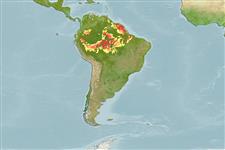Classification / Names
Common names | Synonyms | Catalog of Fishes (gen., sp.) | ITIS | CoL | WoRMS | Cloffa
Actinopterygii (ray-finned fishes) >
Characiformes (Characins) >
Characidae (Characins) > Characinae
Etymology: Charax: Charax, -akos = a fish without identification (Ref. 45335).
Environment / Climate / Range
Ecology
Freshwater; benthopelagic; pH range: 6.2 - 7.5; dH range: ? - 25. Tropical; 22°C - 27°C (Ref. 2059), preferred ?
South America: lower Amazon River basin in Brazil (Ref. 36811). Reported from Suriname (Ref. 59052).
Size / Weight / Age
Maturity: Lm ? range ? - ? cm
Max length : 10.1 cm SL male/unsexed; (Ref. 36811)
Because of its form, this species is very easy to capture with a net. The males are very much smaller than the females. Reproduction takes place during the rainy season. The eggs are deposited on the vegetation and its incubation lasts for 30 hours. Below 6 cm, the juveniles prefer to feed on the larvae of Chironomidae and to a lesser degree on Cladocera. Then, by order of preference, they feed on shrimps, Odonata nymphs and fish juveniles of Ctenobrycon and Curimata (Ref. 12225). Frequents all types of environment (Ref. 27188).
Life cycle and mating behavior
Maturity | Reproduction | Spawning | Eggs | Fecundity | Larvae
Planquette, P., P. Keith and P.-Y. Le Bail, 1996. Atlas des poissons d'eau douce de Guyane. Tome 1. Collection du Patrimoine Naturel Volume 22, MNHN, Paris & INRA, Paris. 429 p. (Ref. 12225)
IUCN Red List Status (Ref. 115185)
CITES (Ref. 94142)
Not Evaluated
Threat to humans
Harmless
Human uses
More information
Common namesSynonymsMetabolismPredatorsEcotoxicologyReproductionMaturitySpawningFecundityEggsEgg development
ReferencesAquacultureAquaculture profileStrainsGeneticsAllele frequenciesHeritabilityDiseasesProcessingMass conversion
Tools
Special reports
Download XML
Internet sources
